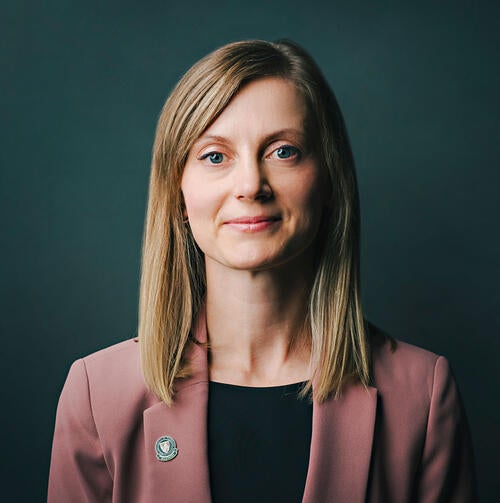
A new chapter in manufacturing
Waterloo lab helps fill industry demand for experts in additive manufacturing

Waterloo lab helps fill industry demand for experts in additive manufacturing
By University Relations
Mihaela Vlasea
Professor, Faculty of Engineering
>Research Co-Director, Multi-Scale Additive Manufacturing Lab
In recent years, factories have been steadily modernizing their facilities with more automation and manufacturing capabilities. With faster and better additive manufacturing solutions that can custom-make durable parts in one piece without the expense of the tooling, a new and exciting chapter in digital manufacturing has begun. This shift has attracted a new generation of engineers back to the shop floor.
“Additive manufacturing is reshaping the way manufacturing looks,” says Mihaela Vlasea, a professor in mechanical and mechatronics engineering and associate director at the Multi-Scale Additive Manufacturing (MSAM) lab at the University of Waterloo. “It's bringing more excitement back into manufacturing, especially for this young generation of students who live in the digital space.”
The MSAM lab is Canada’s largest academic-based research and development facility in metal additive manufacturing. It has state-of-the-art machinery and custom 3D printers that work with composites such as graphene, polymers and ceramics. The lab offers research programs and courses in support of graduate programs and runs regular workshops benefiting professionals working across industry sectors.
“There is a huge need for people with skills in additive manufacturing processes, material science, design for additive manufacturing, data science and process optimization,” Vlasea says. “We are finding that we can barely hold on to our students as they finish their degrees. Sometimes they leave for industry and come back to finish their degrees part-time.”
Additive manufacturing is a high-tech skill. But as more companies are scaling up production to fabricate parts and services for their customer base, finding experts with this skillset is not easy. People tend to think of metal additive manufacturing as a simple matter of pushing a button to have a perfect part pop out, but setting up a successful print requires multidisciplinary skillsets. “It takes a lot of effort to be able to define all of the little levers in the process to generate quality parts, but once you have your designs and process parameters optimized, which is where skilled workforce comes in, production is good to go,” Vlasea says.
Additive manufacturing requires multidisciplinary skills and integrates everything from materials science and product design to robotics and computational data analytics, she says. Even areas such as machine learning and computer vision are part of it.
Vlasea is part of the MSAM team that includes research director Ehsan Toyserkani. The lab has a complement of more than 65 people including faculty, postdoctoral fellows and research associates, technicians, graduate and undergraduate students. The lab has graduated more than 57 MASc and PhD students from their programs and has employed 66 co-op students.
One of Vlasea’s current students, Roman Boychuk (‘BASc), is pursuing his master’s in mechanical engineering with a focus on simulating and predicting sintering behavior in binder-jet additive manufacturing. It is a cost-effective method of 3D printing that allows for fabricating parts out of powder media. Boychuk was drawn to this field in high school when he acquired a plastic 3D printer and began making protypes and parts for his drone. His hobby developed into a realistic career path through his undergrad experiences at Waterloo.
“My co-op terms in manufacturing and the courses I took in materials, solid mechanics and automation furthered my interest in metal additive manufacturing, and perfectly coincided with learning about the MSAM Lab at Waterloo,” Boychuk says. “My interest in additive manufacturing as a powerful enabling tool still remains and is one of my continuing motivations for helping to make additive manufacturing more accurate and affordable.”
Boychuk says that additive manufacturing is an exciting space to work in right now because it is such a powerful tool with potential to solve existing problems and opportunity for new discoveries. “I hope to follow up my academic work with experience in industry, helping to develop these tools and apply them to solve engineering challenges in a fast-paced environment.”
A talent evolution is underway, and the effects are being felt in every sector. Waterloo’s robust talent ecosystem is equipped to respond — from world-leading co-operative education programs to research and innovations that drive real-world change. Learn how your organization can benefit.

Read more
Snapcommerce taps into Waterloo talent to innovate and scale fast

Read more
Lifelong learning program equips CPAs for industry disruption and a technology-driven future

Read more
Rogers and Sportsnet work with Waterloo students to innovate fan experience
The University of Waterloo acknowledges that much of our work takes place on the traditional territory of the Neutral, Anishinaabeg, and Haudenosaunee peoples. Our main campus is situated on the Haldimand Tract, the land granted to the Six Nations that includes six miles on each side of the Grand River. Our active work toward reconciliation takes place across our campuses through research, learning, teaching, and community building, and is co-ordinated within the Office of Indigenous Relations.